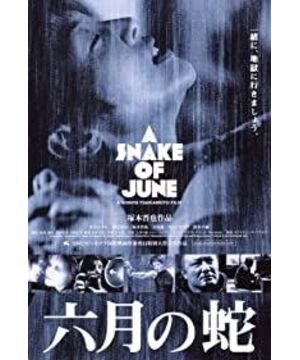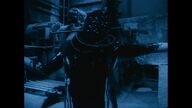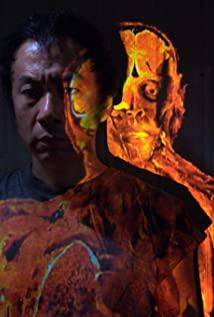text_fa not stick to neon
Tsukamoto Shinya once said: "I sometimes feel weird because one part of me loves Tokyo, and the other part is eager to destroy it." His paradox has also been extended to his works, For example, his treacherous and violent [Iron Man], and this cold and damp [Snake of June]. On the one hand, Tsukamoto Shinya spurned the world in front of him, and on the other hand, he tried his best to embrace this world. Perhaps it was the extreme opposition he cherished that was able to create the cool-toned dance of [Snake of June]. At the shooting site of the voyeur's repayment body portrait, the female model is working hard to "perform" the climax, and the fragrant pictures are transformed into piles of photos... In the editorial department, the photographer who took the piles of photos calmly explained: "Only It takes a big camera and flash to make her orgasm." With the help of external tools, the catharsis of desire seems to have found a shortcut. In contrast to this, another photographer on the side, Michiro Yeguchi, handed over a stack of dildo photos. From his perspective, the person who is the subject of desire no longer exists, and desire has been completely reduced. for the item itself. Two piles of photos placed side by side on the desk, with desire on the left and tools on the right, seem to be warming up for the appearance of the absent "person". [Snake of June] is about a woman's process of conquering her desires. Tatsumi Rinko is an employee who works at the telephone consultation office of the mental health center. Her daily job is to answer calls from all kinds of helpers. Most of them are trapped in the quagmire of life, hoping that someone will give them a hand. Rinko's warm voice is like the possession of the Virgin, exuding an irresistible tolerance. "Do what you want to do", these are the words she often talks about to comfort those who seek help. For her, this "psychiatrist" job is just an operation process on the assembly line. Until the fateful phone call rang - "I'm going to commit suicide." The slightly desperate tone on the phone came from the photographer Michiro Yakuchi at the beginning of the movie, but this did not make Rinko timid, she was accustomed to this, and skillfully enlighten each other. Rinko's husband, Tatsumi Shigehiko, is a man with a serious cleanliness addiction. He will wipe the sink and bathtub in his home vigorously, but he has no concern for his wife, and he is completely unaware that his wife suffers from breast cancer. The distance between the two when they are in the same room says it all: the husband is sitting on the far side of the desk, operating the computer, while the wife is reading on the edge of the coffee table on the ground. And the family’s estrangement didn’t stop there. The husband often slept on the lounge chair in the living room all night, and the film later revealed the truth about their lack of sex through the photographer’s mouth (Rinko’s Breast cancer is also caused by prolonged abstinence). Photographer Michiro Yeguchi was also terminally ill. He had lost hope in life and had the idea of suicide. He went to the rescue center with the mentality of trying, but he was really moved by Rinko, and then he began to observe this "rescue" himself. The woman, peeping at her and photographing her secretly, he discovered the other side hidden under Rinko's appearance - a woman struggling with repressed desires. Michiro Yuguchi is played by Shinya Tsukamoto himself. Shinya Tsukamoto, who has been used to playing the villain in films since the early days, plays a character who is both good and evil. In order to repay Rinko for saving himself, the voyeur came up with the idea. Intimidation and temptation to make Rinko "do what she wants to do": forcing her to wear miniskirts in the mall, forcing her to go to an adult store to buy masturbation sticks... He helped Rinko step into a series of "restricted areas" to obtain psychological and physical Double satisfaction in return for Rinko's "life-saving grace". "Bunuel of Japan" Darren Aronofsky once admitted that the act of the protagonist in [Death Code] aiming the electric drill at his temple was inspired by [Iron Man], and [Requiem of Dreams] The repressed facial close-up in Qu] is also a technique that Shinya Tsukamoto likes to use. In [Snake of June], Rinko's wet facial shots appeared many times: in the toilet of the subway, in the alley on a rainy night, in front of the stove in the kitchen... Moisture and desire often come in and out together, and a wet face not only It points to the excitement before the desire, and it is also the release after satisfying the desire. Shigehiko, played by Yuji Kamizu, doesn't have an impressive performance, but a few close-ups of his face magnify the sin in him. Although this character is attached to a sense of delicacy most of the time: he doesn't smoke, drink, or fool around, and looks like a perfect model husband, but his indifference to his wife is undoubtedly a stifling change in happiness. In addition to the depressing scenes, the surreal scenes in Shinya Tsukamoto's films are also endless, which has long been his label. For example, the lascivious performance scene and the hallucination of drowning in the venue are reminiscent of the various mysterious stages and permeating smoke in the David Lynch movies. As for the tentacle-like metal tube that stretched out after the photographer kidnapped Shigehiko, some people think that this is Shigehiko's fear of impotence. However, some people think that the snake that represents the Garden of Eden is the inducement of desire, because It was the "guidance" of the photographer Yingkou that allowed Rinko to capture her desire. From the diamond phallus in [Iron Man] to the "tentacles" of [Snake of June], Tsukamoto Shin has always been paranoid about metal, but also showed his fear of "human alienation" as always. What makes [Snake of June] add a bizarre and surreal atmosphere, as well as the supporting role The happy Ishikawa Tadashi, who is the old partner of Tsukamoto Shinya, has been working together since the first time the two collaborated with [Tie Nan]. At this year's Venice Film Festival, he attended the "Plain Wildfire" soundtrack, wearing unruly yellow hair and laughing wildly in front of reporters' cameras. Ishikawa Tadashi is deeply influenced by Japanese underground music. His music is full of penetrating power, and he is a hit with the geek Shin Tsukamoto. Industrial dance music style, like a roar from hell after another. Different from the loud and strong metal carnival in [Iron Man], the soundtrack in [Snake of June] is a gloomy low-pitched sound, the rain outside the house will never stop, and the people inside are sighing in despair. Whenever a character is pushed into a moral corner, the low and hoarse theme music plays - when Rinko sees the photo sent by the photographer; when the voyeur goes back and makes more "explicit" demands; When Rinko gave in to her inner desires and pressed the remote control switch of the masturbation stick... This feeling of powerlessness is in the same vein as [Tie Nan]. If the rebellion in [Tie Nan] is a blow to the industrial civilization, then [June] The Serpent] shows the dry skin after the spirit has been drained. City and body Tsukamoto Shin also grew up in Tokyo, a period of high economic development. Since he was a child, he has watched 10- and 20-story buildings rise up from the ground. The crazy growth of cement forests isolates people and divides them into secret rooms one after another. , he felt as terrifying as being in captivity. At the age of 30, Tsukamoto Shin also became more and more sensitive, and the world around him began to be surrounded by computers, so he expressed his fear of the loss of physical perception in [Tokyo Tekken]. In his films, there are always one or two empty shots of tall buildings standing tall. Tall buildings have occupied the city, just as industry and technology have occupied the human body, and he always spares no effort to show the morbid outlook of Japanese society in his films. Tsukamoto Shinya said that the men in [Snake of June] are the symbols of Japanese males, who are huddled in their own world, evading responsibility and fearing communication. For example, Rinko's husband Shigehiko, his life is filled with work, home is more like a hotel to him, and work has become a harbor for him to avoid responsibility. Attend my mother's funeral. Perhaps this explains the recurring snail in the movie, huddled and motionless in its shell, resting on its solitary leaf. For Rinko, glasses are the switch of her personality, severing her double world. Wearing glasses, she is an angel with a sweet voice, who calmly saves people in danger, and then fades away. Behind the glasses, she is like a water demon with her hands and feet in shackles. She can't stop being teased by her desires, and it is rare to have fun. The high-rise concrete wall closed off the outside world and imprisoned the people living in it. Tsukamoto Shin also used blue filters to add to this sense of alienation. The empty house and the cold food are all indifferent husbands and wives. An externalized manifestation of a relationship, two souls without communication living together day after day. At work, Rinko can guide those who can't think about it to "face your heart", but she herself only dares to hide in the bedroom and secretly admire her body in the mirror. The irony of "the rescuer can't save himself" is self-evident. Compared with Tsukamoto Shinya's early "Tie Nan" or "Youkai Biyuko", "Snake of June" has been much smoother in terms of performance, but this is still a very Tsukamoto Shinya's work, his mature It is reflected in the ease of moving the mirror and the control of the rhythm. The three characters hold up the whole story, and they also have rival scenes between them. The scene where Rinko masturbates in the rain in the alley is the climax of the whole film: Rinko is spiritually relieved; the photographer realizes his masturbation. Repay the plan; and the impotent husband also regained his desire. The repression that Tsukamoto Shinya had planted before was finally resolved in this scene. Tsukamoto Shin also said that what he wants to express through the film is that in this era when human nature is about to be flattened, some broken relationships can still be repaired, but the premise is to try. That's why, when we look at the source, the "goodness" that guides Rinko still comes from the world itself, from the reflection after she lends a helping hand. Therefore, the photographer's "returning the favor" is not only not obscene, but shines with a holy light. Published in the October 2014 issue of "Watching Movies Midnight" , and they also have rival scenes with each other. The scene where Rinko is masturbating in the rain in the alley is the climax of the whole film: Rinko is spiritually relieved; the photographer realizes his plan of repayment; and the impotent husband also Desire was regained. The repression that Tsukamoto Shinya had planted before was finally resolved in this scene. Tsukamoto Shin also said that what he wants to express through the film is that in this era when human nature is about to be flattened, some broken relationships can still be repaired, but the premise is to try. That's why, when we look at the source, the "goodness" that guides Rinko still comes from the world itself, from the reflection after she lends a helping hand. Therefore, the photographer's "returning the favor" is not only not obscene, but shines with a holy light. Published in the October 2014 issue of "Watching Movies Midnight" , and they also have rival scenes with each other. The scene where Rinko is masturbating in the rain in the alley is the climax of the whole film: Rinko is spiritually relieved; the photographer realizes his plan of repayment; and the impotent husband also Desire was regained. The repression that Tsukamoto Shinya had planted before was finally resolved in this scene. Tsukamoto Shin also said that what he wants to express through the film is that in this era when human nature is about to be flattened, some broken relationships can still be repaired, but the premise is to try. That's why, when we look at the source, the "goodness" that guides Rinko still comes from the world itself, from the reflection after she lends a helping hand. Therefore, the photographer's "returning the favor" is not only not obscene, but shines with a holy light. Published in the October 2014 issue of "Watching Movies Midnight"
View more about A Snake of June reviews








